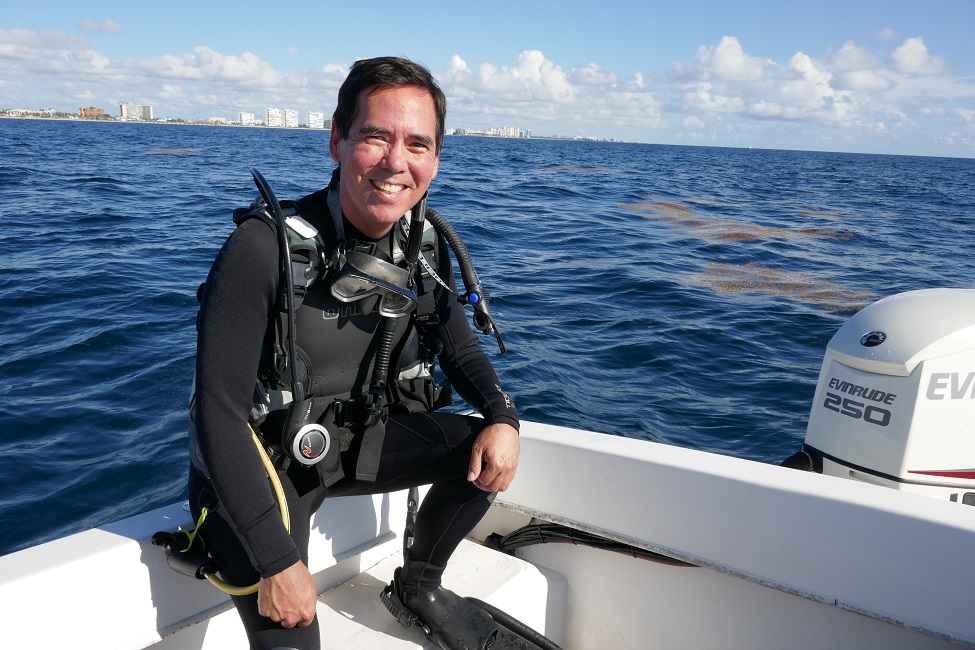Shark Researcher Receives Leon H. Charney Foundation Gift

Stephen Kajiura, Ph.D., a professor of biological sciences in FAU’s Charles E. Schmidt College of Science, is the principal investigator of the program and director of the Elasmobranch Research Laboratory at FAU.
An internationally renowned shark researcher at Florida Atlantic University has received a $117,501 gift from the Leon H. Charney Foundation, Inc. for a joint program with the University of Haifa in Israel. The FAU Elasmobranch Collaborative Research program incorporates both laboratory and field components to gain a better understanding of shark abundance and their distribution along the eastern Mediterranean Sea. Spanning about 965,000 square miles, the Mediterranean Sea is home to at least 47 species of sharks including blacktip, hammerhead, and dusky sharks. Knowledge about the factors that contribute to their aggregations in this region is key as they have begun to increase in numbers locally, in just the past few years.
Stephen Kajiura, Ph.D., a professor of biological sciences in FAU’s Charles E. Schmidt College of Science, is the principal investigator of the program and director of the Elasmobranch Research Laboratory at FAU. His area of expertise is the sensory biology of sharks and stingrays with an emphasis on the electrosensory system.
“I think the research that the teams at FAU and Haifa University are collaborating on is integral to our understanding of marine life and how it functions,” said Tzili Charney. “For that reason, I am honored to help these researchers in any way that I can.”
As part of the research collaboration, Kajiura and colleagues from the University of Haifa will instrument the sharks with newly developed data logging cameras to collect environmental data such as water temperature, light level, salinity, and 3axis magnetic heading/intensity. This information will help them to determine environmental parameters as sharks swim and will provide the most comprehensive view of their interactions in the wild.
“In order to understand what sharks are doing in their natural habitats, we need to see how they interact with various stimuli, such as other sharks, prey fish, and aquaculture cage pens,” said Kajiura. “We also need to understand their preferred habitats by documenting environmental parameters, such as water temperature, depth and salinity.”
Kajiura and collaborators also will test sharks’ olfactory (sense of smell) sensitivity to stimuli, further explore how they detect magnetic fields, study their auditory capabilities to determine the range of frequencies they can hear, and test how they interact with other marine life. An overarching goal of the project is to develop techniques to keep sharks away from certain areas. To achieve this goal, the researchers will test the efficacy of various shark deterrents including the PVC pole barrier, which does not entangle any sea life, does not corrode, is inexpensive and can easily be removed, and galvanic field deterrents that produce electric fields.
“Sharks are unique among fishes because they possess an electrosensory system that enables them to detect magnetic fields via electromagnetic induction,” said Kajiura. “However, this hypothesized mechanism has never been empirically tested. If we can get a better understanding of their sensitivity to magnetic stimuli, we may be able to develop and test effective shark repellents.”
To examine olfaction, Kajiura and collaborators will test sharks’ physiological responses to amino acids, prey tissue and other materials. They also will conduct a series of hearing tests and will employ behavioral assays to determine how sharks respond to stimuli.
In the United States, Kajiura studies the massive seasonal migration of blacktip sharks in South Florida, which is the largest migration in U.S. coastal waters. He incorporates aerial surveys using drones and a fixed-winged aircraft with a camera as well as tagging and acoustic telemetry to document migration patterns. Kajiura has been tracking blacktip sharks’ migration patterns for about a decade. Last year, he observed a dramatic decline in the thousands of blacktip sharks that migrate south every year.
“These blacktip sharks have an important ecological impact in South Florida,” said Kajiura. “Data from these studies, as well as the studies that we are going to conduct in the eastern Mediterranean Sea, will enhance our ability to keep an eye on the oceans and census shark populations, and monitor animal responses to climate change.”
To facilitate collaboration, students from FAU and the University of Haifa will participate in a student exchange program. In the summer, Kajiura will travel to the Leon H. Charney School of Marine Science to offer a condensed one-month graduate level course on the biology of sharks and their relatives – the same course he teaches at FAU.
“We are very grateful to the Leon H. Charney Foundation for this most generous gift to Dr. Kajiura, which will foster collaboration among our universities and expose students to research opportunities that are not available at their home institution,” said Ata Sarajedini, Ph.D., dean of FAU’s Charles E. Schmidt College of Science. “Furthermore, the additional data that will be collected as a result of this collaboration will help to preserve vital shark species in the eastern Mediterranean Sea and protect humans from unwanted encounters in the wild.”
-FAU-
Tags: faculty and staff | science | research | philanthropy